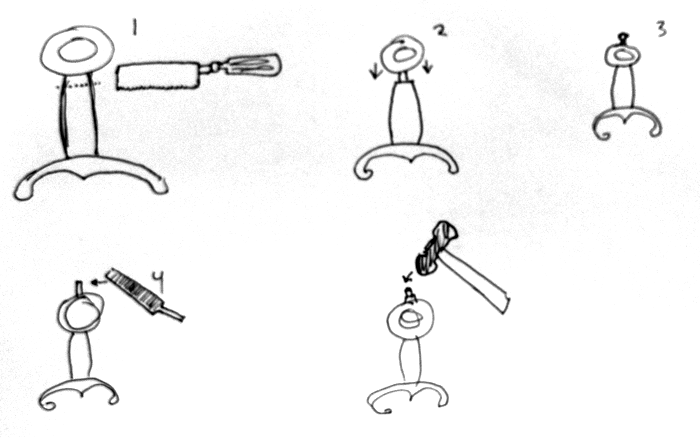• Unless you're worried about offending the maker, you could ask him if the pommel compresses the grip or if it is tightly fitted to the tang, and won't slide down. That is the important question, and the answer will tell you how to proceed.
• If the pommel compresses the grip, or if you're not sure how it is fitted to the tang, you should saw around the top of the grip down to the tang, remove that unwanted length of grip and see if the pommel will drop down to the cover the gap. If that works, all you have to do is file the sides of the peen to make the tang straight (no need to shorten the tang,) put on a block and re-peen. Done! Look for a little X-acto hobby saw http://compare.ebay.com/like/290720352929?var...p;var=sbar . These have very thin blades for accurate cutting. If this method leaves the grip too thick at the top, remove the grip cover and carve or sand the grip core appropriately and re-cover.
• If you want to make a new grip, rest the grip on a hard surface (anvil is perfect,) rest a chisel on the edge of the grip and strike the chisel with a hammer, starting with light blows and increasing in power until the grip splits. If the grip is not well glued, you can then just pry it off the tang. If it is heavily glued, you might have to use the chisel to remove some parts of the grip.
• On many modern swords, the pommel compresses the grip. Without the grip, the pommel will slide down enough to expose the peen. You might have to strike the pommel with a mallet to get it to drop. THIS WILL NOT WORK IF THE SWORD IS MADE LIKE AN ALBION or A&A. If the pommel is tightly fitted to the tang, it will not drop. In that case, you will have to get a drill bit the size of the peen and slowly drill down far enough to eliminate the peen. If you create a peen block, it will cover the resulting depression in the pommel. If you flush-peen, the peen will fill the depression.
